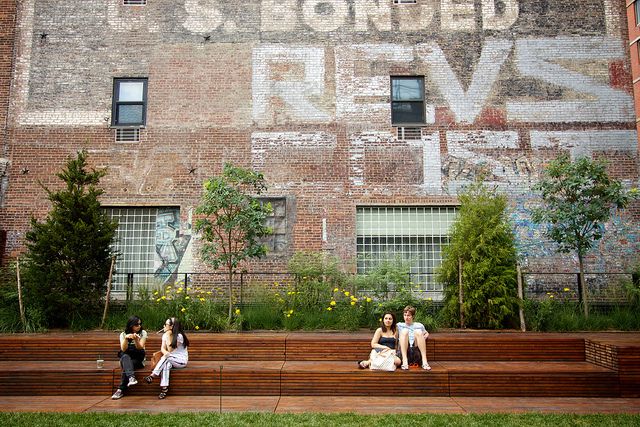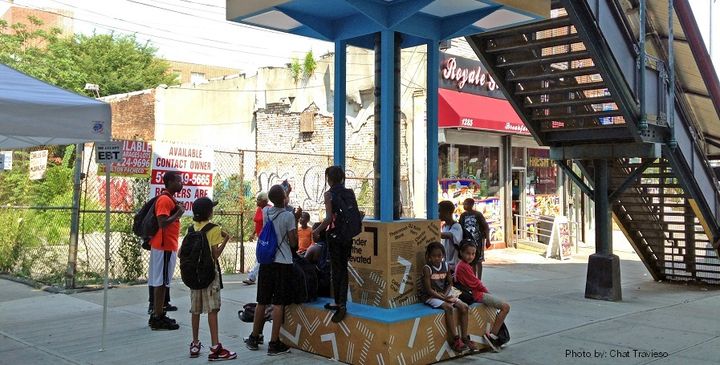
The High Line sees more than 5 million visitors annually.
Authenticity has long been considered an important feature of urban design. From The High Line in New York City to The Rail Park in Philadelphia, successful public spaces often reflect the very qualities that make their city unique. And yet the overall endurance of these projects hinges on a broader, and perhaps even more vital, characteristic: inclusivity. As Jane Jacobs famously said, “Cities have the capability of providing something for everybody, only because, and only when, they are created by everybody.”
Today, a growing number of urban development projects are prioritizing both individuality and quality of place in their designs. As a result, modern real estate developers have made placemaking a key element of their development strategies, culminating in projects like Wynwood Walls in Miami and Edens’ Union Market in Washington, D.C. Still, projects like these are far from ubiquitous. In cities around the world, there is plenty of work be done to build more inclusive and authentic communities for all residents to enjoy.
To understand the importance of public space and designing for inclusivity, I caught up with placemaking guru Rosamond Fletcher, the Director of Programs at the Design Trust for Public Space. Founded in 1995, the Design Trust brings together government agencies, community groups, and private-sector experts to transform New York City’s urban landscape.
Steven Pedigo: Why is public space so important to communities?
Rosamond Fletcher: Public space reaffirms our humanity. It gives us space to breathe, reflect, and be together. When we have a communal experience in public space—a performance on the subway, a protest in Washington Square Park, a BBQ or cricket match in Flushing Meadows—we understand each other and ourselves better. In our current volatile political climate, the role of public space in connecting us and building greater empathy is more important than ever.
Do these spaces have economic value as well?
Yes, projects like the High Line in NYC are clear evidence of how value is created through public-private investment in public space. But not every community wants or needs a High Line. When the Design Trust for Public Space completed its “Reclaiming the High Line” study in 2002, we were focused on the structure’s best use as an open space. I don’t think anyone involved fully anticipated the extent of its popularity and value in catalyzing real estate. Today, with growing income inequality and segregation, the challenge for city leaders and practitioners is to control development so that stable, diverse communities and improvements to public space are not mutually exclusive. Equitable development starts with the community, but it should not undermine what’s great about neighborhoods in the first place.
What's one of your favorite public spaces? Why?
I have to say the Staten Island Ferry, which is my daily public transit from St. George to Manhattan. It's a very lively social space, great for people watching or striking up conversations with strangers. It offers a diverse mix of commuters from the island as well as tourists seeking a free view of Lady Liberty. The hum of many languages, the excitement of children spotting a six-story container ship or brightly colored tugboat, and the polite greetings of the deck hands all make the space seem immeasurably human. The John F. Kennedy, my favorite ferry, was built with an open plan and acts as an oversize floating living room for people to take in the natural beauty and activity of the New York Harbor. The lightness of the space, expansive views across the water, and route past Ellis Island all conspire to impart the value of openness to those onboard.
What is creative placemaking, and are there different types?
Creative Placemaking is a term coined by the National Endowment for the Arts in 2010. I like to think of it as a cultural practice that spans different sectors and disciplines, helping to strengthen a community’s quality of place and leverage that quality of place into the development of a neighborhood on a broader scale. Placemaking can take many forms: events and programming, pop-up and pilot interventions, asset mapping, cultural planning, citywide toolkits, as well as new public spaces, buildings, and developments.

The Boogie Down Booth pays tribute to the music legacy and future of the Bronx.
Can you share with us an example of a successful initiative? What made it a success?
In 2013, the Design Trust collaborated with the Women’s Housing and Economic Development Corporation (WHEDco) and NYC Department of Transportation on the “Boogie Down Booth,” a pop-up solar-powered bus stop that played music that originated in the Bronx. The Booth, designed by Design Trust Fellows Chat Travieso and Neil Donnelly, was successful as a placemaking initiative because it brought together local merchants, residents, and musicians to reimagine an area beneath the tracks. It inspired changes by the community, such as a new, closer location for the local fruit vendor, and advanced our larger “Under the Elevated” project by demonstrating the community demand for el-spaces, or underutilized spaces beneath road and rail infrastructure. It also demonstrated the need for new approaches to lighting design and street furniture. While there are many aspects that contributed to the project’s success, the most important was our cross-sector partnership, which was grounded in the vibrancy of Bronx culture.
Another project I greatly admire is Paths to Pier 42, a joint venture resulting in an annual pop-up park on Pier 42 along the East River Waterfront. As a community design organization, Hester Street Collaborative (HSC) commissioned artists and designers to create interactive installations and programming, encouraging the local community to use and adapt the area over the course of three-plus summers. HSC also coordinated with Mathews Nielsen, the landscape architect responsible for the master plan, to incorporate what they learned from the community.
How do communities get started?
Talk to your neighbors and find other champions or a partner. Think big, but start small. Bite off a manageable piece of the project that will tangibly demonstrate why your initiative is critical to the community. It’s helpful to consider phasing your project to build the political leverage and resources necessary to realize your goals.
